The name of a bar - what it really tells you, or not
We are no longer building saddle trees, but we have two videos about how Western saddles fit horses available on our westernsaddlefit.com website.
When it comes to bars and how they fit, there is a common idea that certain bars always fit a certain way or are needed for specific uses. In the last couple of months we have heard questions and comments such as these: "The Wade bar fits horses better than other bars." and "Do you have a bar with a lot of rock in it?" And then we hear that Arizona bars are the best for roping trees and cutting bars are needed in cutting saddles. So, what do these names mean and how do they apply to our trees?
What do the names mean?
The answer, as for many things when it comes to saddles and trees, is "nothing specific". It all depends on the tree maker since, as we may have mentioned once or twice, every tree maker does things differently. The bars in production trees are made on duplicating machines of various kinds. This means there is a "master", whether an actual physical bar or a computer program, that sets how the machine routers out the bar shape. So production companies do have set bar patterns that are labelled in some way. For a specific company, bar pattern XYZ will have more rock in it than bar pattern ABC. It will also have a different outline pattern, crown, twist, length, etc. - all the Factors that Affect Tree Fit can be different. But there is no way for a saddle maker to measure and specify these changes or compare the individual components between the bars. You just get the finished bar to check on horses to see how it fits.
So how do you know how they are supposed to fit without ordering one? Some companies put out written descriptions of how they compare. Here's a sample from a couple companies' descriptions: "Not quite as much rocker and twist as the Wade bar. Approximately same rocker as the Arizona bar." "Front bar pads are real flat." "Flatter rear rafter also and less bow for broad, flat backs with little dip." These are general terms but they still tend to compare one bar to another, so you have to know what their other bar is like to understand the description of this one. But at least the companies are trying to describe the fit. Another production company has a whole series of forms they will send out for you to try on your horse to see which of their bar types (designated by letter combinations) fits him the best. Then you order a tree with that letter designation to fit your horse. But, again, these forms only apply to that company as no one else has bars shaped exactly like them in all ways. So the names really mean nothing between different makers at all.
Arizona bars
The exception to this are Arizona bars. There are a lot of differences between companies as to how their Arizona bars fit, but the one consistent thing between all of them is that they only have a front stirrup groove and not a back one. Some companies make bars with other names and shapes that they call "Arizona style" because they only have a front stirrup groove. We will always put in a full stirrup groove, and I wrote the "Of Arizona bars and why we won't make them" post to explain our reasoning.
So what do we do?
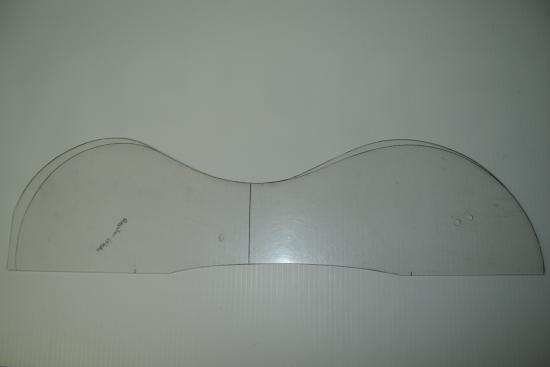
We have two names for our bars, Wade and regular, but those names apply only to the outline pattern. For us, a Wade bar is 1/4" deeper in the front and back bar pads than the regular, and has 1/2" longer front bar tip to accommodate the extra stock thickness on a typical Wade fork. The width at the back of the stirrup groove is the same between the patterns. We use the regular outline pattern for trees with 4 1/4" or less stock thickness and the Wade fork pattern for trees with 4 1/2" or more stock thickness.
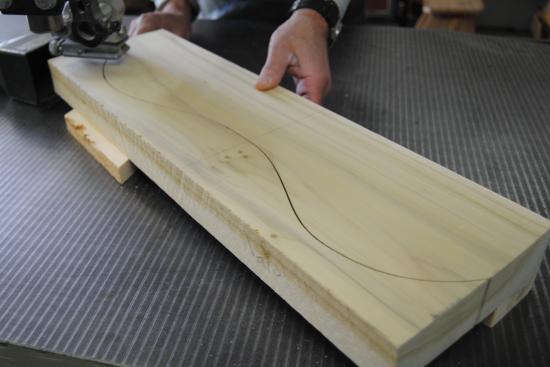
These patterns get drawn onto the wood glued up for the bars, but since our bar length varies with the seat length and all the factors that change that, we adjust the pattern in the center make the correct bar length. We also narrow the center as needed to keep it close to the same width across the back of the stirrup groove regardless of the bar spread and angle, and we can narrow that a bit as well on request. Then Rod cuts out the bars on the band saw along this line.
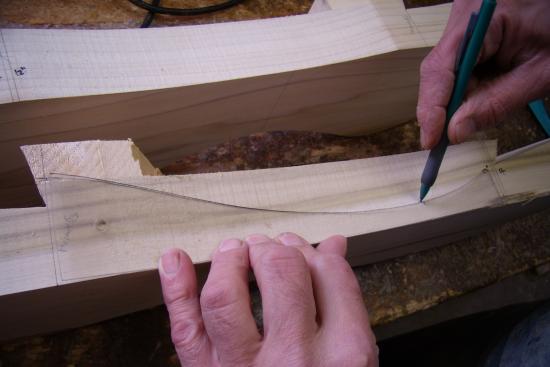
To set the rock and twist, Rod then marks out the edges of the bars using a combination of patterns
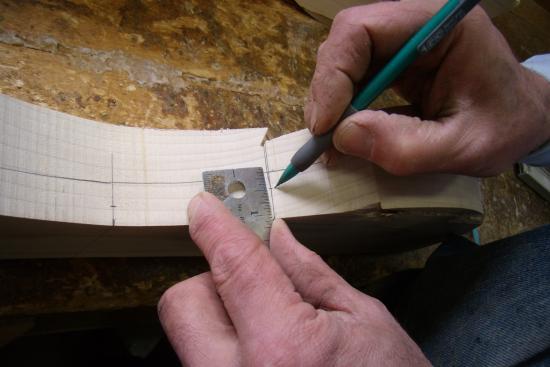
and very specific measurements.
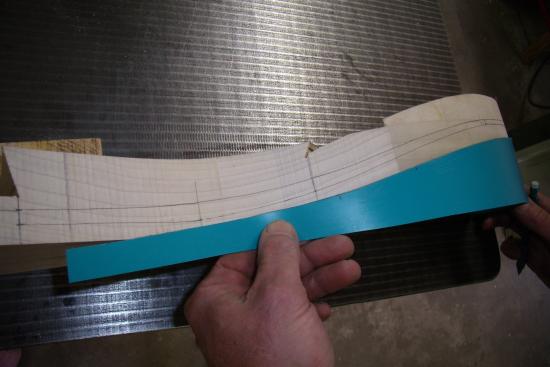
So when he is done, there are two longitudinal lines on both the outside
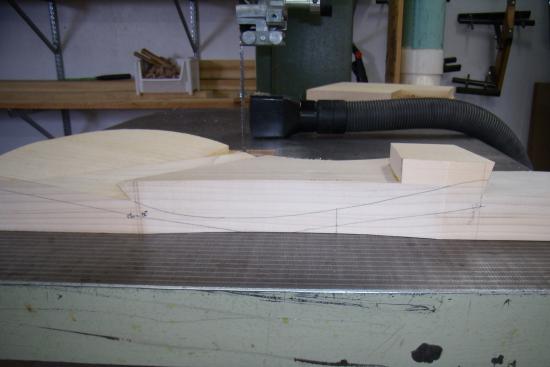
and the inside of the bars. Some of these are used as basic guide lines only, and others he uses to shape to very exactly. You can see that if the shape or position of the lines change relative to the top and bottom of the bar, it will change rock and twist in the bar.
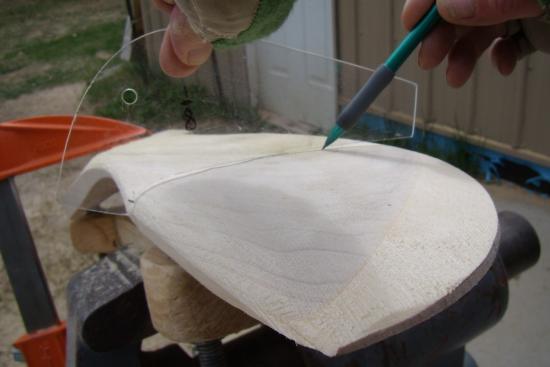
When Rod goes to shaping the bars, he uses patterns to set the amount of crown he wants. We have a few different patterns for the amount of crown, both front and back.
So for us, we don't have a "named bar pattern" that has a specific rock, twist and crown. We have two outline patterns and we change these other factors to be what they need to be. We can and do change them individually when necessary. You don't have to change everything about a bar to have a different amount of rock, for example. We also keep track of all this so we know what we do for every set of bars we build.
Does that mean that every set of bars is different and we have no "standard" bar types?
Not at all. We work to fit different body types, and we have found that certain rock, twist and crown patterns tend to go with certain bar spreads and angles. We are also seeing more of a correlation of specific factors with certain disciplines, probably because horses working in that discipline have similar body types. By using the Dennis Lane Equine Back Profiling System, we have learned a lot more about how these different factors tend to correlate as well. (Some pictures and information about how the system is used is described on our Measuring Horses for Fit page.) Over the years we have expanded the number of variables we have made for body types that are not the "typical Western ranch horse back" (though it is very interesting to see how many other breeds and types of horses are fit by the same basic bar specs that usually fit a "typical Western ranch horse back".)
So when someone asks us "do you have a bar with more rock in it?", the answer we give is "Yes, we can make a bar with more rock in it." We can also make it consistently without duplicating machines or copying a "master pattern" by always using the same measurements to mark out the bars. And no, all Wade bars do not all fit the same way, and no, a Wade bar does not fit a horse better than any other bar. We can make a regular outline pattern bar fit just the same way a Wade outline pattern bar fits.
A better way?
We are coming to believe that a better way to talk about bar fits is not to name or describe the bar, but to describe the type of horse that a tree with that bar will fit. Dennis Lane's system now gives us the opportunity to do this. For example, rather than "lots of rock" or "it fits a flatter backed horse", we can say "this bar fits a horse with an R6 amount of rock". (R6 is the designation of one of the four rock cards in the Dennis Lane system.) The tree maker can build his bars however he wants in order to fit that amount of rock, but by labelling the horse shape he is fitting rather than his bar pattern, the fit will be more consistent between makers and the customer will know what it is too.
The same thing applies to the other factors that affect fit as well. Since the designation for different bar angles means nothing between makers, saying that a tree will fit a horse that is, for example, D4 at the A position with enough twist to make them D8 at the B position and D9 at the C position would bring some consistency for the saddle buying public. At the same time, it would still allow the tree makers to build their trees following their own philosophy of fit and in the manner that they use to build trees, whether it is by duplicating machines or with individual measurements. Who knows if it will ever happen, but it sure is something to think about...
By the way, the pictures in this post are copied mainly from our Building the Bars page, which has more pictures and information on how Rod makes our bars. For those who are interested in seeing more, just click on the link.
